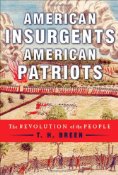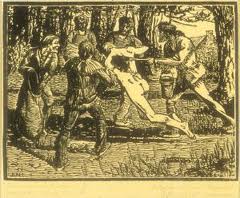
American Insurgents, American Patriots by T. H. Breen
 T.H. Breen’s well-documented book offers a different perspective on the American Revolution. According to Breen, the celebrated men of the Continental Congress are rightly revered for having founded the American nation. However, wise and well schooled in the philosophies of governance as they were, there is more to the story than has been told.
T.H. Breen’s well-documented book offers a different perspective on the American Revolution. According to Breen, the celebrated men of the Continental Congress are rightly revered for having founded the American nation. However, wise and well schooled in the philosophies of governance as they were, there is more to the story than has been told.
Breen does not suggest that such men as Adams, Franklin and Washington should be honored less. Rather, his thesis is that the ordinary men, who took up arms before the Declaration of Independence was written, should be honored more.
These are the people who chose not to submit to a government they perceived as unjust and a threat to their constitutional rights as Englishmen. Â Without those people, Breen asserts, there would have been no Revolution and no independent nation.
Today, we call those ordinary people patriots. Their contemporaries called colonists who defied parliamentary rule, insurgents; thus, the book’s title.
The author does not disappoint. In vivid prose, Breen brings together facts about the Revolution not found in popular histories. He draws from a variety of sources that steep the reader in the language, values and mores of the period. For example, he cites the first mathematical demographer, Benjamin Franklin, who determined that the American population was doubling every 25 years.
As Breen explains, a population explosion of that magnitude means that at any given time a large percentage of the population consists of young people. Throughout the Revolution about half of the colonists were under age 16. “The implication of the youth culture for an account of the coming independence is profound …Their knowledge of earlier controversies was second hand. What young insurgents knew–in intimate and direct terms– was a sudden surge in popular violence that occurred during the summer of 1774 and culminated in the killing of Americans at Lexington and Concord.â€
The common perception that political discontent over the hated Stamp Act of 1765 produced the insurgency of 1775 is less persuasive when we realize that many of the insurgents were small children during the early 1760s.
Similarly, many revolutionary accounts focus on urban centers: Boston and Philadelphia, for example. However, the majority of revolutionary families lived on small farms and were members of small, close knit communities.
Breen tells their story through the journals and diaries of the farmers, tradesmen and ministers who were angered at the injustice of the Coercive Acts and the army of occupation sent to Boston to enforce them. Closing the port of Boston to commerce; restructuring Massachusetts colonial government so that council members were appointed by the crown instead of by the house of representatives; and limiting town meetings to only one a year, were all regarded as infringements of colonists’ English constitutional rights.
Confident in their God-given rights, driven by anger against an imperial government that treated them like second-class subjects, American insurgents resisted parliamentary rule, first spontaneously, as loosely organized militants who purged the countryside of crown officials, and then, increasingly after 1774, as members of local committees of safety that became schools for revolution.
The author asserts that the story of ordinary citizens has to be told to fully understand our nation’s origins. Breen’s book reveals a messy and, at first, uncoordinated and locally led popular resistance. The author also builds a case for the influence of evangelical Protestantism in framing the insurgency in religious terms. He quotes a Philadelphia writer who, during the summer of 1774, explained, “The man who refuses to assert his right to liberty—property—and life—is guilty of the worst type of rebellion. He commits high treason against GOD.â€
The arrogance of Parliament’s edicts ignited the insurgency. Ordinary men and women who had held aloof from protests against the empire, now united in outrage. Throughout New England, families demonstrated their disaffection for the Crown’s policies. Some stopped drinking tea. Others boycotted British imported goods. Finally, there was a general call for the creation of a Continental Congress to formally address the King and Parliament and find a way out of the colonies’ difficulties.
However, protests against the Coercive Acts did not wait upon the First Continental Congress. Throughout New England, people began refusing to obey the King’s representatives. They closed courts, diverted local tax revenues from the King’s tax collectors to trusted treasurers, and disbanded and reformed militias under the control of colonial officers. In so doing they also demonstrated the impotence of their British overseers. Perhaps most significant, they began to think in terms of an American cause before there was an American nation.
 Insurgents also practiced an eighteenth century version of political correctness against individuals within their communities who professed loyalty to the Crown. Social and commercial shunning, and in extreme cases, tar and feathers, were powerful persuaders. The fact that imperial authorities were, in the author’s words, “thin on the ground†put the loyalists at a definite disadvantage. Most saw the wisdom in publicly recanting. Those who did so were welcomed back to the fold. Breen makes no excuses for these events, citing them as expressions of the political rage that swept New England in 1774.
Insurgents also practiced an eighteenth century version of political correctness against individuals within their communities who professed loyalty to the Crown. Social and commercial shunning, and in extreme cases, tar and feathers, were powerful persuaders. The fact that imperial authorities were, in the author’s words, “thin on the ground†put the loyalists at a definite disadvantage. Most saw the wisdom in publicly recanting. Those who did so were welcomed back to the fold. Breen makes no excuses for these events, citing them as expressions of the political rage that swept New England in 1774.
The colonists were not all of one mind. Breen estimates that one-third were insurgents, one-third loyalists and the remaining third undecided. By channeling outrage into resistance, the insurgents forced the undecided to take sides.
By the time the First Continental Congress met in Philadelphia in September, 1774, the delegates realized that the initiative was no longer theirs.’ The rumor, that the British battle fleet had destroyed Boston, generated a spontaneous army that marched to do battle with British troops in Boston, only turning back when the rumor was found to be false. These events profoundly influenced events in Philadelphia.
The Congress that was supposed to lead the nation now found themselves in the awkward position of becoming followers of ordinary people who had already defined the character of the resistance against Great Britain. “Popular politics on the ground forced the delegates to endorse a policy far more provocative than anything they might have anticipated before setting out for Philadelphia.â€
In an effort to stop events from spinning out of control, Congress, on October 20, 1774, endorsed a general boycott of British manufactured goods known as the Association. Breen writes, “Instead of causing the revolution to dissipate or run amok, … continental leaders produced a brilliant structure that at once legitimized Congress’s leadership and authorized the people to sustain, define and channel the insurgency within their own communities.â€
By leaving the problem of organizing committees and policing violations to the local communities, insurgents were able to proceed according to local political and social conditions. Here, in effect, were experiments in republican government predating the Declaration of Independence.
It is no doubt true, as Breen attests, ordinary people were the muscle that moved the Revolution ahead. However, the special genius of the Congress was in finding ways to harness events, provide a structure for the insurgents, and avoid anarchy.
Breen describes the various forms the committees of safety or observation took throughout the continent. These committees seized control of local governments and not only “determined the progress of revolution†but drew newcomers into the political process. They “transformed the colonial political culture†and “played a central role in the development of a republican form of government in the United States.†Equally important, they kept a lid on revolutionary violence.
Breen devotes the rest of the book to the ways in which the insurgency spread throughout the colonies. In a society in which communication depended upon a fast horse, the insurgents found ways to communicate. They bypassed newspapers sympathetic to the Crown and created their own. Newspaper stories about distant communities organizing to resist Great Britain packed a powerful emotional charge. Such stories also raised the possibility that what was happening in Boston could happen to anywhere.
Breen introduces us to the common man of the revolutionary age, ordinary people who questioned the establishment and who saw fit to challenge the authority of the mightiest empire in the world. They did not start out with succession in mind. They were not political theorists, but they understood that if free men accommodate to tyranny, sooner or later, they will cease being free.
Breen’s book would be important at any time but it has special meaning in our time.
The ideas that gave meaning to the American insurgency posses a simple elegance. The central element in popular political thought was a set of rights that God gave every man and woman long before they established a civil government. These rights were universal; every human being could claim them. But rights carried responsibilities. God expected the people to preserve their rights. However burdensome this duty may have been in theory. it served to empower ordinary people in the contest with tyranny. As vigilant defenders of rights, they became judges of those who held authority, and in the imagined compact that bound rulers to subjects, it was the subjects who determined whether the magistrates were in fact working for the common good.
At the end of the book he writes, “ And now, as so many other people throughout the world demand their rights and justice, they challenge modern Americans to remember their revolutionary origins.â€
However readers wish to interpret his message, that is good advice.
 The posts are coming!
The posts are coming!


2 comments
This post was referred to by The Sentry Journal.
Agreed. This was a well-written and insightful book.
[Reply]
Leave a Comment